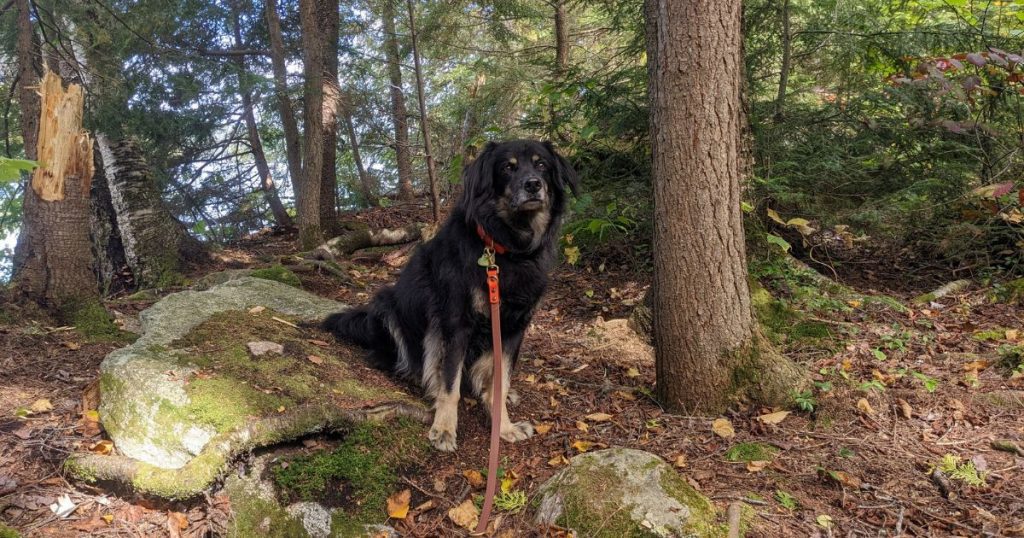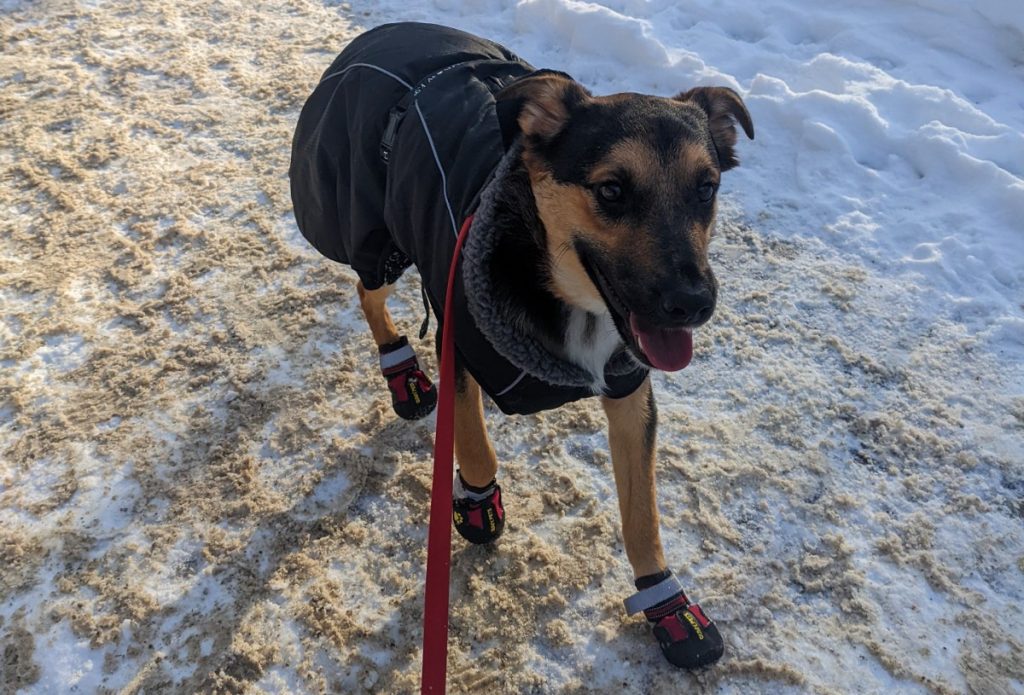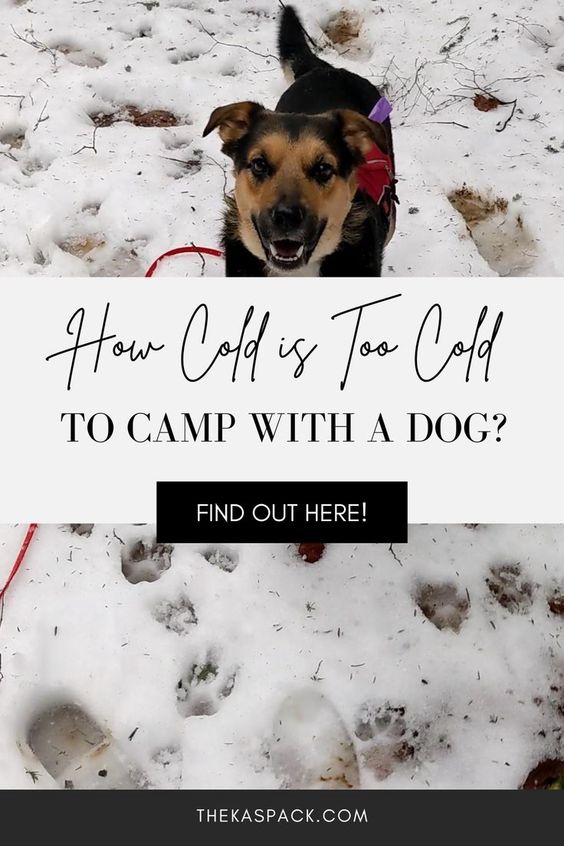How Cold is Too Cold to Camp with a Dog?
The temperatures are dropping, and fall is officially here.
For some, this spells the end of the camp season. However, those of us who love the beautiful fall colours recognize that camping during the cooler months can be an amazing experience.
But this raises an important question – How cold is too cold to camp with a dog?
Our pack just returned from a 9-day fall tent camping trip on a beautiful waterfront property. We take this trip during the same week every year and the temperatures vary considerably from year to year.
Two years ago, we spent much of our September trip wearing t-shirts and enjoying the sunshine. But this year was much chillier.
Whether you’re debating heading out to enjoy the brisk fall air or considering your first winter camping trip with your dog by your side, cool weather camping is all about preparation.

This post contains affiliate links, which means if you click and buy, we will make a commission (at no cost to you). See my full disclosure policy for more details.
How Cold is Too Cold for a Dog?
The first major consideration when discussing fall or winter camping is to determine your dog’s limitations. How cold is too cold for a dog? There is no one easy answer or benchmark to consider. Instead, several factors will influence what temperatures your dog can handle outdoors comfortably.
Dog Breed
One of the biggest factors that is going to determine how cold is too cold to camp with a dog is the breed of dog that you have. Regardless of where we live now with our pets, their ancestry reaches back to a wide variety of different countries and areas. A dog breed that hails from the mountains of Alaska is going to be better equipped for cooler temperatures than a dog breed that originally came from Africa.
Coat Type
Your dog’s coat type has a direct impact on their ability to stay warm when temperatures drop. While some dogs have short coats that offer little to no protection or insulation, other dogs are better equipped.
A double-coated dog has two distinct layers of fur. The topcoat is made of coarse guard hairs that offer a layer of protection. Beneath that, the undercoat is softer and woolly to the touch that acts like the insulation in a winter coat. Dogs with a double coat often thrive in cold weather.
Age
Young puppies are particularly susceptible to cooler temperatures. If you are bringing a new pup into the home, most experts suggest waiting until your dog is older before braving cold weather for any extended period. On the other end of the spectrum, dogs that are entering their golden years often start to feel the cold a little more.
Can You Take a Dog Winter Camping?
While fall camping is gaining in popularity in recent years, the idea of winter camping may seem a little out there. There are many ways to get out there and enjoy the great outdoors in the cold and snow – even here in Canada!
Your big winter adventure could range from cold tenting and relying on body heat to curling up with your pup next to a wood stove in a cozy log cabin.
But winter camping with a dog and spending an extended time outdoors in the bitter cold presents some unique risks. One of the biggest risks that your dog may face in the winter if you head out ill-prepared is hyperthermia. Often associated with people, this is a condition that isn’t as common among our canine friends. Smaller dogs, puppies, elderly dogs, and those with short coats are at a higher risk.
The common warning signs of hypothermia in dogs include:
- Shivering
- Low heart rate
- Shallow breathing
- Dilated pupils
- Weakness or lethargy
- Collapse
- Coma
If you take your dog winter camping and notice any of these signs, contact your veterinarian as soon as possible. The sooner your dog is given treatment, the better their chances of a full recovery.

How Do I Know if My Dog is Cold?
If there is no easy answer to the question “how cold is too cold to camp with a dog”, then how do you know if your dog is comfortable during your next trip? The key is learning how to identify if your dog is cold by recognizing the subtle warning signs.
It would be a lot easier if our dogs could speak and tell us how they are feeling in each situation. Unfortunately, it’s not that easy. Instead, we need to pay attention to the physical signs. A dog that is too cold may start shivering or lifting their paws to keep them off the cold ground. They may try to warm themselves up by hunching down or seeking any form of shelter.
What about at night? How do I know if my dog is cold while sleeping? You may see your dog shaking or shivering, but the more obvious sign in most cases is your dog’s attempt to warm himself up. This could include curling up in a small ball, tucking their nose in behind their tail, or burrowing into their bedding.
How Can I Keep My Dog Warm?
Cold weather doesn’t have to spell the end of your outdoor adventures. There are several steps that you can take to keep your dog warm and cozy. This includes a variety of different gear options created specifically for the comfort of our canine companions. Check out these options for effectively keeping a dog warm camping.
Dog Coats and Sweaters
One of the most common ways of keeping a dog warm is by using a coat or sweater. There are many different types available depending on your dog’s size, body type, comfort level with clothing, and the temperatures that you are going to be facing.
In the fall months, when the temperatures are just a little chillier, a fleece vest-style jacket or blanket-style jacket may be all that your dog requires. It offers a little added warmth without too much bulk. This also makes it more comfortable for dogs that aren’t used to wearing clothing, allowing them to move freely.
When the temperatures dip even further in the late fall and into the winter, there are two common options to choose from. A body warmer or overall is a full-body suit that covers both the dog’s body and legs. They are also regularly used for anti-anxiety, to contain shedding, and to prevent a dog from accessing an incision post-surgery.
Finally, there is the traditional winter coat. Like a human coat, these offer both protection from the elements and some added insulation. Our youngest boy Lucifer wears a winter coat in the coldest months, which has allowed us to learn a couple of important aspects to watch out for to maximize warmth. We prefer a coat with an adjustable waistband to fit the coat to his body preventing wind from getting inside and bringing a chill. We also stick with coats that have a higher collar or one that can be pulled up when needed for added warmth.
Dog Boots
Another piece of must-have gear for our little man Lucifer is a pair of winter dog boots. Not only do they protect his paws from the cold snow and ice, but they also provide a little extra traction on slippery surfaces. He wasn’t a huge fan of them at first. We had to introduce them slowly at home with lots of praise and, of course, treats. But now he gets excited the moment that he sees us pulling out his winter gear.
Dog Sleeping Bags
As humans, we invest in quality sleeping bags for the colder nights. Why would we not do the same for our best friends? There are many great dog sleeping bag options that pack up for easy transport just like the ones that we use while providing our dogs with a comfortable place to burrow into for a warm, comfortable night’s sleep.
Heated Dog Beds
If you are camping somewhere with access to electricity, you may want to invest in a heated outdoor dog bed – especially during the cold winter months. These are especially great for dogs that are more susceptible to low temperatures, giving them a warm, comfortable place to retreat to. When shopping for an electric bed, pay careful attention to those designed for indoors versus outdoors. Outdoor beds are built specifically to keep everyone safe when using electricity in the elements.
For those that are more rustic campers and don’t have an electrical connection, there are self-heating sleeping pads that you can incorporate into your dog’s bed setup. These reflect your dog’s body heat back to them to keep them warm throughout the night (or during a chilly daytime nap).
Tent Heaters
While this item isn’t specifically designed for dogs, it is worth mentioning. If you plan on going winter tent camping, you may wish to invest in a propane tent heater to take the chill off in your tent. Be careful to choose a heater that is indoor-safe with safety measures in place to protect you and your dog against carbon monoxide poisoning and the potential risk of fire that it may create.

Campfires and Campfire Safety
Of course, there is always the option of building a roaring fire that you can curl up next to with your dog. Who doesn’t love a campfire?
If you are planning on relying on your fire pit as the primary source of warmth, make sure to always supervise your dog carefully. Don’t allow them to stand or lay too close to the fire where they are at risk of catching a stray ember. You may also have to keep a close eye on the firewood that you are putting into the pit if you have a dog that loves sticks. After all, no one wants their trip to end with a trip to the nearest emergency veterinarian.

Hopefully, this helps you answer the question of how cold is too cold to camp with a dog with your pup in mind. What steps do you take to keep your best friend warm when the temperatures drop?
